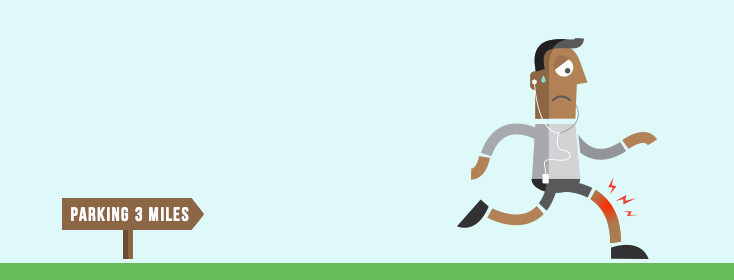Would You Like Something with that RA, Ma'am?
Last updated: January 2024
You’d think all the problems that rheumatoid arthritiscauses—the pain, disability, fatigue, fevers, and that general, all-around cruddy feeling—would be enough.
Unfortunately, you’d be wrong. It turns out there’s a whole slew of other diseases and conditions, referred to as “comorbidities,” that those of us who’re coping with this RA need to watch out for, too. It seems that once you have RA, you’re far more likely to get these, as well.
When my doctor diagnosed me with RA 27 years ago, I had no real understanding of the disease. I could barely believe I had arthritis, let alone that I was now in very real danger of getting other nasty diseases and conditions because I had it. I can’t recall him saying anything about RA’s comorbidities, either. I didn’t find out about them until 17 years later.
This or That
Are you newly diagnosed (1 year or less) with RA?
Was this hip pain an RA flare?
I’d been out on a long walk on a local, 10-mile-long nature trail with my little dog, Finny. I’ll admit I probably walked too far—about six miles, total—when I really wasn’t used to it. But the spring-like day had been bright and cool and way too pretty to waste. The wild lands on both sides of the trail were beautiful.
On the way back, still about a mile from my car, my hip suddenly started feeling odd, like it was about to slide out of its socket. It hurt a little, too, but didn’t feel like the flares in my hips I’d had during the first several years after diagnosis. Those had been truly horrific. They’d come on suddenly, the pain ramping up to nearly unbearable in minutes, then remaining that way for two to four days. Those flares were crippling. Devastating.
This pain wasn’t like that. It only hurt, mildly, in that strange, elongated moment when my leg felt like it was coming loose. Then the feeling would wane. Walking carefully and much, much more slowly, afraid of falling, I made it back to my car and home.
In the weeks following, I’d get that same odd feeling—without warning—in my hip joint now and then. I was also feeling a mean, insistent, deep ache in both hips when I was in bed at night. It forced me to change positions all night long, waking me repeatedly. I dreaded and feared the possible return of those long ago hip-flares.
Hip or trochanteric bursitis
It turned out that rheumatoid disease wasn’t what was causing my hip pain. At least, not directly. My rheumatologist identified it as trochanteric, or hip, bursitis. The bursa is a small, oval-shaped sac of fluid that cushions and protects the hip joint. In bursitis, the bursa becomes inflamed, which causes it to be tender and often, very painful.
“Did my walking cause it?” I asked. Finny and I had really enjoyed those walks, and we missed them. The idea that we’d have to stop doing them bummed me out.
He shook his head. While overuse can cause bursitis, usually in joggers and serious hikers, he said he didn’t think that was what caused mine. Instead, he felt it had appeared as a comorbidity of my rheumatoid disease.
The impact of RA inflammation
Trochanteric bursitis—indeed, all types of bursitis—is a common comorbidity, he explained. The inflammation RA causes is systemic, meaning that it occurs throughout the body, not just in the joint capsules and around the joints. It attacks soft tissues like the bursae, too—and the connective tissues like tendons, ligaments, and cartilage. Since that first attack of chronic bursitis (it has never gone away, but comes and goes mysteriously), I’ve also developed lateral epicondylitis—also known as tennis elbow. It’s a type of tendinitis, and I didn’t get it playing tennis.
The system inflammation of rheumatoid disease can be far more serious, though. It can attack the lining of the heart, causing heart disease that precipitates heart attacks and strokes. That people with RA often become overweight or obese because joint pain prevents them from moving well and exercising doesn’t help.
The lining of the lungs can become inflamed, too, causing pleurisy. RA and some of the medications used to treat it, like methotrexate and corticosteroids, can scar the lungs, too. Rheumatoid nodules—bumps or lumps that may form beneath the skin of the elbows or knees—can also form inside the lungs, as well. These can cause obstruction and a condition known as rheumatoid lung.
Then there’s rheumatoid vasculitis. The blood vessels anywhere in the body can become inflamed, causing them to narrow and weaken, sometimes to the point of stopping blood flow to organs and limbs.
Other comorbidities
Other comorbidities of RA include Sjogren’s syndrome, which causes drying of the eyes and mucous membranes; Raynaud’s Phenomenon, a disorder of the blood vessels that supply the skin; Non-Hodgkin’s lymphoma, a type of blood cancer that’s two to four times riskier for people with RA than those without the disease. Some drugs used to treat RA—methotrexate and some biologic disease-modifying anti-rheumatic drugs (DMARDs)—can also increase the risk of contracting lymphoma.
Finally, those with RA are more prone to infections because of its constant high level of systemic inflammation. In addition, several of the drugs that suppress the immune system in order to slow or stop the progress of RA also make it harder for the body to fight off infections.
I don’t know about you, but I’ve had about enough of all this. Have you experienced any of the comorbidities of rheumatoid arthritis?
Community Poll
What flare symptom do you wish you could avoid the most?

Join the conversation